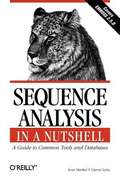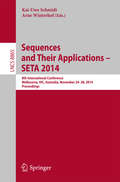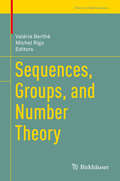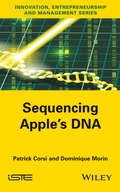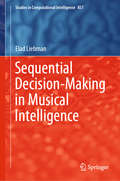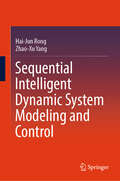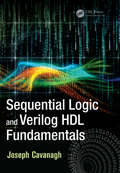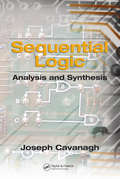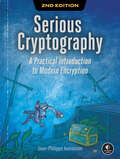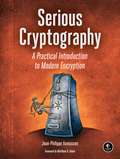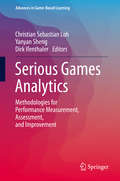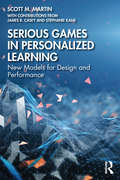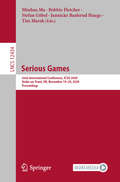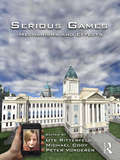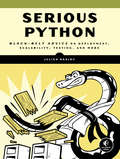- Table View
- List View
Sequence Analysis in a Nutshell
by Darryl Leon Scott MarkelSequence Analysis in a Nutshell: A Guide to Common Tools and Databasespulls together all of the vital information about the most commonly used databases, analytical tools, and tables used in sequence analysis. The book contains details and examples of the common database formats (GenBank, EMBL, SWISS-PROT) and the GenBank/EMBL/DDBJ Feature Table Definitions. It also provides the command line syntax for popular analysis applications such as Readseq and MEME/MAST, BLAST, ClustalW, and the EMBOSS suite, as wel
Sequences and Their Applications - SETA 2014
by Arne Winterhof Kai-Uwe SchmidtThis book constitutes the refereed proceedings of the 8th International Conference on Sequences and Their Applications, SETA 2014, held in Melbourne, VIC, Australia, in November 2014. The 24 full papers presented together with 2 invited papers were carefully reviewed and selected from 36 submissions. The papers have been organized in topical sections on Boolean functions, perfect sequences, correlation of arrays, relative difference sets, aperiodic correlation, pseudorandom sequences and stream ciphers, crosscorrelation of sequences, prime numbers in sequences, OFDM and CDMA, and frequency-hopping sequences.
Sequences, Groups, and Number Theory
by Valérie Berthé Michel RigoThis collaborative book presents recent trends on the study of sequences, including combinatorics on words and symbolic dynamics, and new interdisciplinary links to group theory and number theory. Other chapters branch out from those areas into subfields of theoretical computer science, such as complexity theory and theory of automata. The book is built around four general themes: number theory and sequences, word combinatorics, normal numbers, and group theory. Those topics are rounded out by investigations into automatic and regular sequences, tilings and theory of computation, discrete dynamical systems, ergodic theory, numeration systems, automaton semigroups, and amenable groups. This volume is intended for use by graduate students or research mathematicians, as well as computer scientists who are working in automata theory and formal language theory. With its organization around unified themes, it would also be appropriate as a supplemental text for graduate level courses.
Sequencing Apple's DNA
by Patrick Corsi Dominique MorinThis book aims to extract the "molecular genes" leading to craziness! Geniuses are the ones who are "crazy enough to think they can change the world" and boldly go where no one has gone before. Where no past habit and usage are available, there is no proof of viability, as nobody has done it yet, or even imagined it, and no roadmap for guidance or market study has come up with it. The authors call upon Leonardo Da Vinci, the Renaissance genius, who as strange as it seems, shared many traits of personality with that of Steve Jobs, in terms of the ways of performing. Da Vinci helps in understanding Jobs, and hence Apple, with his unique way of designing radically novel concepts, which were actually quite crazy for his time. In order to shed light on a special creative posture, the indomitable sense of specifying undecidable objects - a hallmark of the late Steve Jobs - is what led the authors to match it with a specific design innovation theory. A real theory, backed by solid mathematical proof, exists and can account for the business virtue of a prolific ability to move into unknown crazy fields! The authors postulate that, by bringing the power of C-K theory to crack open a number of previous observations made about Apple's methods, it is possible to identify most of the genes of this company. The authors analyze how and why an Apple way of doing business is radically different from standard business practices and why it is so successful. Genes are a measure of the entity at hand and can encourage past business education routine approaches, then become transferable across the spectrum of the socio-economic world.
Sequential Decision-Making in Musical Intelligence (Studies in Computational Intelligence #857)
by Elad LiebmanOver the past 60 years, artificial intelligence has grown from an academic field of research to a ubiquitous array of tools used in everyday technology. Despite its many recent successes, certain meaningful facets of computational intelligence have yet to be thoroughly explored, such as a wide array of complex mental tasks that humans carry out easily, yet are difficult for computers to mimic. A prime example of a domain in which human intelligence thrives, but machine understanding is still fairly limited, is music. Over recent decades, many researchers have used computational tools to perform tasks like genre identification, music summarization, music database querying, and melodic segmentation. While these are all useful algorithmic solutions, we are still a long way from constructing complete music agents able to mimic (at least partially) the complexity with which humans approach music. One key aspect that hasn't been sufficiently studied is that of sequential decision-making in musical intelligence. Addressing this gap, the book focuses on two aspects of musical intelligence: music recommendation and multi-agent interaction in the context of music. Though motivated primarily by music-related tasks, and focusing largely on people's musical preferences, the work presented in this book also establishes that insights from music-specific case studies can also be applicable in other concrete social domains, such as content recommendation.Showing the generality of insights from musical data in other contexts provides evidence for the utility of music domains as testbeds for the development of general artificial intelligence techniques.Ultimately, this thesis demonstrates the overall value of taking a sequential decision-making approach in settings previously unexplored from this perspective.
Sequential Intelligent Dynamic System Modeling and Control
by Hai-Jun Rong Zhao-Xu YangThe book offers novel research results of sequential intelligent dynamic system modeling and control in a unified framework from theory proposals to real applications. It covers an in-depth study of various learning algorithms for the permanent adaptation of intelligent model parameters as well as of structural parts of the model. The comprehensive researches on sequential fuzzy and neural controller design schemes for some complex real applications are included. This is particularly suited for readers who are interested to learn practical solutions for controlling nonlinear systems that are uncertain and varied at any time. In addition, the organization of the book from addressing fundamental concepts, and presenting novel intelligent models to solving real applications is one of the major features of the book, which makes it a valuable resource for both beginners and researchers wanting to further their understanding and study about realtime online intelligent modeling and control ofnonlinear dynamic systems. The book can benefit researchers, engineers, and graduate students in the fields of control engineering, artificial intelligence, computational intelligence, intelligent control, nonlinear system modeling, and control, etc.
Sequential Logic and Verilog HDL Fundamentals
by Joseph CavanaghSequential Logic and Verilog HDL Fundamentals discusses the analysis and synthesis of synchronous and asynchronous sequential machines. These machines are implemented using Verilog Hardware Description Language (HDL), in accordance with the Institute of Electrical and Electronics Engineers (IEEE) Standard: 1364-1995. The book concentrates on sequential logic design with a focus on the design of various Verilog HDL projects. Emphasis is placed on structured and rigorous design principles that can be applied to practical applications. Each step of the analysis and synthesis procedures is clearly delineated. Each method that is presented is expounded in sufficient detail with accompanying examples. Many analysis and synthesis examples use mixed-logic symbols incorporating both positive- and negative-input logic gates for NAND (not AND) and NOR (not OR) logic, while other examples utilize only positive-input logic gates. The use of mixed logic parallels the use of these symbols in the industry. The book is intended to be a tutorial, and as such, is comprehensive and self-contained. All designs are carried through to completion—nothing is left unfinished or partially designed. Each chapter contains numerous problems of varying complexity to be designed by the reader using Verilog HDL design techniques. The Verilog HDL designs include the design module, the test bench module that tests the design for correct functionality, the outputs obtained from the test bench, and the waveforms obtained from the test bench. Sequential Logic and Verilog HDL Fundamentals presents Verilog HDL with numerous design examples to help the reader thoroughly understand this popular hardware description language. The book is designed for practicing electrical engineers, computer engineers, and computer scientists; for graduate students in electrical engineering, computer engineering, and computer science; and for senior-level undergraduate students.
Sequential Logic: Analysis and Synthesis
by Joseph CavanaghUntil now, there was no single resource for actual digital system design. Using both basic and advanced concepts, Sequential Logic: Analysis and Synthesis offers a thorough exposition of the analysis and synthesis of both synchronous and asynchronous sequential machines. With 25 years of experience in designing computing equipment, the author stresses the practical design of state machines. He clearly delineates each step of the structured and rigorous design principles that can be applied to practical applications. The book begins by reviewing the analysis of combinatorial logic and Boolean algebra, and goes on to define sequential machines and discuss traditional and alternative methods for synthesizing synchronous sequential machines. The final chapters deal with asynchronous sequential machines and pulse-mode asynchronous sequential machines. Because this volume is technology-independent, these techniques can be used in a variety of fields, such as electrical and computer engineering as well as nanotechnology.By presenting each method in detail, expounding on several corresponding examples, and providing over 500 useful figures, Sequential Logic is an excellent tutorial on analysis and synthesis procedures.
Serialization and Persistent Objects
by Jiri Soukup Petr MacháčekRecently, the pressure for fast processing and efficient storage of large data with complex relations increased beyond the capability of traditional databases. Typical examples include iPhone applications, computer aided design - both electrical and mechanical, biochemistry applications, and incremental compilers. Serialization, which is sometimes used in such situations is notoriously tedious and error prone. In this book, Jiri Soukup and Petr MacháÄ ek show in detail how to write programs which store their internal data automatically and transparently to disk. Together with special data structure libraries which treat relations among objects as first-class entities, and with a UML class-diagram generator, the core application code is much simplified. The benchmark chapter shows a typical example where persistent data is faster by the order of magnitude than with a traditional database, in both traversing and accessing the data. The authors explore and exploit advanced features of object-oriented languages in a depth hardly seen in print before. Yet, you as a reader need only a basic knowledge of C++, Java, C#, or Objective C. These languages are quite similar with respect to persistency, and the authors explain their differences where necessary. The book targets professional programmers working on any industry applications, it teaches you how to design your own persistent data or how to use the existing packages efficiently. Researchers in areas like language design, compiler construction, performance evaluation, and no-SQL applications will find a wealth of novel ideas and valuable implementation tips. Under http://www. codefarms. com/book, you will find a blog and other information, including a downloadable zip file with the sources of all the listings that are longer than just a few lines - ready to compile and run.
Seriation in Combinatorial and Statistical Data Analysis (Advanced Information and Knowledge Processing)
by Israël César Lerman Henri LereddeThis monograph offers an original broad and very diverse exploration of the seriation domain in data analysis, together with building a specific relation to clustering.Relative to a data table crossing a set of objects and a set of descriptive attributes, the search for orders which correspond respectively to these two sets is formalized mathematically and statistically. State-of-the-art methods are created and compared with classical methods and a thorough understanding of the mutual relationships between these methods is clearly expressed. The authors distinguish two families of methods:Geometric representation methodsAlgorithmic and Combinatorial methods Original and accurate methods are provided in the framework for both families. Their basis and comparison is made on both theoretical and experimental levels. The experimental analysis is very varied and very comprehensive. Seriation in Combinatorial and Statistical Data Analysis has a unique character in the literature falling within the fields of Data Analysis, Data Mining and Knowledge Discovery. It will be a valuable resource for students and researchers in the latter fields.
Serious Cryptography, 2nd Edition: A Practical Introduction to Modern Encryption
by Jean-Philippe AumassonCrypto can be cryptic. Serious Cryptography, 2nd Edition arms you with the tools you need to pave the way to understanding modern crypto.This thoroughly revised and updated edition of the bestselling introduction to modern cryptography breaks down fundamental mathematical concepts without shying away from meaty discussions of how they work. In this practical guide, you&’ll gain immeasurable insight into topics like authenticated encryption, secure randomness, hash functions, block ciphers, and public-key techniques such as RSA and elliptic curve cryptography.You&’ll find coverage of topics like:The basics of computational security, attacker models, and forward secrecyThe strengths and limitations of the TLS protocol behind HTTPS secure websitesQuantum computation and post-quantum cryptographyHow algorithms like AES, ECDSA, Ed25519, Salsa20, and SHA-3 workAdvanced techniques like multisignatures, threshold signing, and zero-knowledge proofsEach chapter includes a discussion of common implementation mistakes using real-world examples and details what could go wrong and how to avoid these pitfalls. And, true to form, you&’ll get just enough math to show you how the algorithms work so that you can understand what makes a particular solution effective—and how they break. NEW TO THIS EDITION: This second edition has been thoroughly updated to reflect the latest developments in cryptography. You&’ll also find a completely new chapter covering the cryptographic protocols in cryptocurrency and blockchain systems.Whether you&’re a seasoned practitioner or a beginner looking to dive into the field, Serious Cryptography will demystify this often intimidating topic. You&’ll grow to understand modern encryption and its applications so that you can make better decisions about what to implement, when, and how.
Serious Cryptography: A Practical Introduction to Modern Encryption
by Jean-Philippe AumassonThis practical guide to modern encryption breaks down the fundamental mathematical concepts at the heart of cryptography without shying away from meaty discussions of how they work. You’ll learn about authenticated encryption, secure randomness, hash functions, block ciphers, and public-key techniques such as RSA and elliptic curve cryptography.You’ll also learn: - Key concepts in cryptography, such as computational security, attacker models, and forward secrecy - The strengths and limitations of the TLS protocol behind HTTPS secure websites - Quantum computation and post-quantum cryptography - About various vulnerabilities by examining numerous code examples and use cases - How to choose the best algorithm or protocol and ask vendors the right questionsEach chapter includes a discussion of common implementation mistakes using real-world examples and details what could go wrong and how to avoid these pitfalls. Whether you’re a seasoned practitioner or a beginner looking to dive into the field, Serious Cryptography will provide a complete survey of modern encryption and its applications.
Serious Games Analytics
by Dirk Ifenthaler Christian Sebastian Loh Yanyan ShengThis volume brings together research on how gameplay data in serious games may be turned into valuable analytics or actionable intelligence for performance measurement, assessment, and improvement. Chapter authors use empirical research methodologies, including existing, experimental, and emerging conceptual frameworks, from various fields, such as: computer science software engineering educational data mining statistics information visualization. Serious games is an emerging field where the games are created using sound learning theories and instructional design principles to maximize learning and training success. But how would stakeholders know what play-learners have done in the game environment, and if the actions performance brings about learning? Could they be playing the game for fun, really learning with evidence of performance improvement, or simply gaming the system, i. e. , finding loopholes to fake that they are making progress? This volume endeavors to answer these questions.
Serious Games and Edutainment Applications
by Lakhmi C. Jain Andreas Oikonomou Minhua MaThe recent re-emergence of serious games as a branch of video games and as a promising frontier of education has introduced the concept of games designed for a serious purpose other than pure entertainment. To date the major applications of serious games include education and training, engineering, medicine and healthcare, military applications, city planning, production, crisis response, to name just a few. If utilised alongside, or combined with conventional training and educational approaches, serious games could provide a more powerful means of knowledge transfer in almost every application domain. Serious Games and Edutainment Applications offers an insightful introduction to the development and applications of games technologies in educational settings. It includes cutting-edge academic research and industry updates that will inform readers of current and future advances in the area. The book is suitable for both researchers and educators who are interested in using games for educational purposes, as well as game professionals requiring a thorough understanding of issues involved in the application of video games technology into educational settings. It is also applicable to programmers, game artists, and management contemplating or involved in the development of serious games for educational or training purposes.
Serious Games and Edutainment Applications: Volume Ii
by Lakhmi C. Jain Andreas Oikonomou Minhua MaThe recent re-emergence of serious games as a branch of video games and as a promising frontier of education has introduced the concept of games designed for a serious purpose other than pure entertainment. To date the major applications of serious games include education and training, engineering, medicine and healthcare, military applications, city planning, production, crisis response, to name just a few. If utilised alongside, or combined with conventional training and educational approaches, serious games could provide a more powerful means of knowledge transfer in almost every application domain. Serious Games and Edutainment Applications offers an insightful introduction to the development and applications of games technologies in educational settings. It includes cutting-edge academic research and industry updates that will inform readers of current and future advances in the area. The book is suitable for both researchers and educators who are interested in using games for educational purposes, as well as game professionals requiring a thorough understanding of issues involved in the application of video games technology into educational settings. It is also applicable to programmers, game artists, and management contemplating or involved in the development of serious games for educational or training purposes.
Serious Games for Enhancing Law Enforcement Agencies: From Virtual Reality to Augmented Reality (Security Informatics and Law Enforcement)
by Babak AkhgarThis book provides a comprehensive and practically minded introduction into serious games for law enforcement agencies. Serious games offer wide ranging benefits for law enforcement with applications from professional trainings to command-level decision making to the preparation for crises events. This book explains the conceptual foundations of virtual and augmented reality, gamification and simulation. It further offers practical guidance on the process of serious games development from user requirements elicitation to evaluation. The chapters are intended to provide principles, as well as hands-on knowledge to plan, design, test and apply serious games successfully in a law enforcement environment. A diverse set of case studies showcases the enormous variety that is possible in serious game designs and application areas and offers insights into concrete design decisions, design processes, benefits and challenges. The book is meant for law enforcement professionals interested in commissioning their own serious games as well as game designers interested in collaborative pedagogy and serious games for the law enforcement and security sector.
Serious Games in Personalized Learning: New Models for Design and Performance
by Stephanie Kane Scott M. Martin James R. CaseySerious Games in Personalized Learning investigates game-based teaching and learning at a time when learning and training systems are increasingly integrating serious games, machine-learning artificial intelligence models, and adaptive technologies. Game-based education provides rare data for measuring, assessing, and evaluating not just a game’s effectiveness but the acquisition of information and knowledge that a student may gain through playing a learning game. This book synthesizes contemporary research, frameworks, and models centered on the design and delivery of serious games that truly personalize the learning experience. Scholars of educational technology, instructional design, human performance, and more will find a comprehensive guide to the history, practical implications, and data-collection potential inherent to these fast-evolving tools.
Serious Games: 10th Joint International Conference, JCSG 2024, New York City, NY, USA, November 7–8, 2024, Proceedings (Lecture Notes in Computer Science #15259)
by Jan L. Plass Xavier OchoaThis book constitutes the refereed proceedings of the 10th Joint International Conference on Serious Games, JCSG 2024, held in New York City, NY, USA, during November 7–8, 2024. The 19 full papers, 5 short papers, 12 posters and 5 demos included in this book were carefully reviewed and selected from 63 submissions. They were organized in topical sections as follows: Artificial intelligence in serious games; Serious games analytics; Serious game design; Impact studies; Extended realities; Healthcare and wellbeing; Applications.
Serious Games: 4th Joint International Conference, Jcsg 2018, Darmstadt, Germany, November 7-8, 2018. Proceedings (Lecture Notes in Computer Science #11243)
by Minhua Ma Tim Marsh Stefan Göbel Jannicke Baalsrud Hauge Augusto Garcia-Agundez Thomas Tregel Manuel Oliveira Polona CasermanThis book constitutes the proceedings of the 4th International Conference on Serious Games, JCSG 2018, held in Darmstadt, Germany, in November 2018. The 15 full and 12 short papers presented in this volume were carefully reviewed and selected from 40 submissions. They were organized in topical sections named: serious games studies; game-based learning and teaching; game development - serious games design, models, tools and emerging technologies; and serious games for health.
Serious Games: 9th Joint International Conference, JCSG 2023, Dublin, Ireland, October 26–27, 2023, Proceedings (Lecture Notes in Computer Science #14309)
by Stefan Göbel Mads Haahr Alberto Rojas-SalazarThis book constitutes the refereed proceedings of the 9th Joint International Conference on Serious Games, JCSG 2023, held in Dublin, Ireland, during October 26–27, 2023. The 18 full papers presented together with 9 short papers and 14 poster papers were carefully reviewed and selected from 53 submissions. They are grouped into the following topics: technology and systems; theoretical and design aspects; health and wellbeing; extended realities; soft and social skills; academic skills; and posters and exhibits.
Serious Games: Joint International Conference, JCSG 2020, Stoke-on-Trent, UK, November 19–20, 2020, Proceedings (Lecture Notes in Computer Science #12434)
by Minhua Ma Tim Marsh Stefan Göbel Jannicke Baalsrud Hauge Bobbie FletcherThis book constitutes the refereed proceedings of the 6th Joint International Conference on Serious Games, JCSG 2020, held in Stoke-on-Trent, UK, in November 2020. The 19 full papers presented together with 3 short papers were carefully reviewed and selected from 38 submissions. The papers offer a wide range in the use of serious games in several fields like learning, simulation, training, health, well-being, management, assessment or marketing and much more.
Serious Games: Joint International Conference, JCSG 2021, Virtual Event, January 12–13, 2022, Proceedings (Lecture Notes in Computer Science #12945)
by Minhua Ma Tim Marsh Stefan Göbel Jannicke Baalsrud Hauge Bobbie FletcherThis book constitutes the refereed proceedings of the 7th Joint International Conference on Serious Games, JCSG 2021, as virtual event, in January 2022.The 17 full papers presented together with 3 short papers were carefully reviewed and selected from 28 submissions. JSCG 2021 is dedicated to serious games and its interdisciplinary characteristics combining game concepts and technologies required in the different application domains.
Serious Games: Joint International Conference, JCSG 2022, Weimar, Germany, September 22–23, 2022, Proceedings (Lecture Notes in Computer Science #13476)
by Stefan Göbel Philipp Müller Heinrich Söbke Pia SpangenbergerThis book constitutes the refereed proceedings of the 8th Joint International Conference on Serious Games, JCSG 2022, held in Weimar, Germany, in September 2022. The 14 full papers presented together with 5 short papers were carefully reviewed and selected from 31 submissions. JSCG 2022 is dedicated to serious games and its interdisciplinary characteristics combining game concepts and technologies required in the different application domains. This year’s proceedings are categorized into the following topical sub-headings: Learning Psychology, Design Aspects, Game Design, Health Games, Games Application, and Mixed Reality.
Serious Games: Mechanisms and Effects
by Michael Peter Vorderer Ritterfeld Ute CodySerious Games provides a thorough exploration of the claim that playing games can provide learning that is deep, sustained and transferable to the real world. "Serious games" is defined herein as any form of interactive computer-based game software for one or multiple players to be used on any platform and that has been developed to provide more than entertainment to players. With this volume, the editors address the gap in exisiting scholarship on gaming, providing an academic overview on the mechanisms and effects of serious games. Contributors investigate the psychological mechanisms that take place not only during gaming, but also in game selection, persistent play, and gaming impact. The work in this collection focuses on the desirable outcomes of digital game play. The editors distinguish between three possible effects -- learning, development, and change -- covering a broad range of serious games’ potential impact. Contributions from internationally recognized scholars focus on five objectives: Define the area of serious games Elaborate on the underlying theories that explain suggested psychological mechanisms elicited through serious game play, addressing cognitive, affective and social processes Summarize the empirical evidence on the effectiveness of serious games, Introduce innovative research methods as a response to methodological challenges imposed through interactive media Discuss the possibilities and limitations of selected applications for educational purposes. Anchored primarily in social science research, the reader will be introduced to approaches that focus on the gaming process and the users’ experiences. Additional perspectives will be provided in the concluding chapters, written from non-social science approaches by experts in academic game design and representatives of the gaming industry. The editors acknowledge the necessity for a broader interdisciplinary study of the phenomena and work to overcome the methodological divide in games research to look ahead to a more integrated and interdisciplinary study of digital games. This timely and singular volume will appeal to scholars, researchers, and graduate students working in media entertainment and game studies in the areas of education, media, communication, and psychology.
Serious Python: Black-Belt Advice on Deployment, Scalability, Testing, and More
by Julien DanjouAn indispensable collection of practical tips and real-world advice for tackling common Python problems and taking your code to the next level. Features interviews with high-profile Python developers who share their tips, tricks, best practices, and real-world advice gleaned from years of experience.Sharpen your Python skills as you dive deep into the Python programming language with Serious Python. You'll cover a range of advanced topics like multithreading and memorization, get advice from experts on things like designing APIs and dealing with databases, and learn Python internals to help you gain a deeper understanding of the language itself. Written for developers and experienced programmers, Serious Python brings together over 15 years of Python experience to teach you how to avoid common mistakes, write code more efficiently, and build better programs in less time. As you make your way through the book's extensive tutorials, you'll learn how to start a project and tackle topics like versioning, layouts, coding style, and automated checks. You'll learn how to package your software for distribution, optimize performance, use the right data structures, define functions efficiently, pick the right libraries, build future-proof programs, and optimize your programs down to the bytecode. You'll also learn how to: - Make and use effective decorators and methods, including abstract, static, and class methods- Employ Python for functional programming using generators, pure functions, and functional functions- Extend flake8 to work with the abstract syntax tree (AST) to introduce more sophisticated automatic checks into your programs- Apply dynamic performance analysis to identify bottlenecks in your code- Work with relational databases and effectively manage and stream data with PostgreSQLIf you've been looking for a way to take your Python skills from good to great, Serious Python will help you get there. Learn from the experts and get seriously good at Python with Serious Python!
